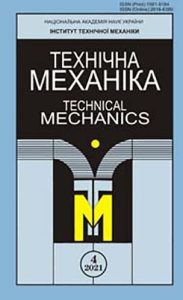Head of department – Corresponding Member of the National Academy of Sciences of Ukraine,
D.Sc., Professor Valerii I. Tymoshenko
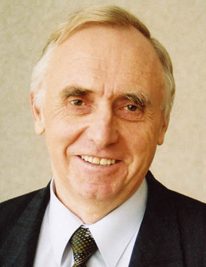
Fields of research :
– aerothermogasdynamics of rockets and launch vehicles, aircraft with direct-flow air-jet engines (AJE);
– the aerodynamic action of the flow impinging on the spacecraft (SC) in orbital conditions and in descent conditions;
– gas dynamics of low-thrust jet engines, their effect on the structural elements of the spacecraft and on the formation of its own external atmosphere around the spacecraft;
– theoretical studies of jet flows and gas dynamics of launching launch vehicles;
– development of algorithms for the on-board active support system of resources of rocket and space objects in various conditions of their operation.
A brief history of research
These studies have been started at the institute from the first days of its foundation at the initiative of the Chief Designer of KB-3 of the State Enterprise M.K. Yangel “Yuzhnoye” Design Office, and then the General Designer of the S. A. Lavochkin NVO, corresponding member of the academies of sciences of the Ukrainian SSR and the USSR V. M. Kovtunenko.
In the 1970s and 1980s, numerical studies of supersonic and hypersonic flow around an aircraft were carried out, simulating an orbital aircraft of the Buran type, which is an analogue of the US Space Shuttle. Research was carried out in cooperation and under contracts with leading enterprises of the aerospace industry of the USSR and Ukraine, the results obtained were among the first in the USSR. In the 1990s, a software and methods were created to calculate the aerodynamic characteristics of rockets with thin control and stabilization bodies. With the use of this software, results were obtained on the aerodynamics of the Oril and Svityaz launch vehicles, which were supposed to be developed within the framework of the third National Space Program of Ukraine in the 2000s.
Regarding the creation in Ukraine of a space rocket (2005-2022) with multiple launches of a space-grade cruise engine (“Cyclone-4″, Cyclone-4M”), a complex mathematical model and software for simulating the operation of low-thrust two-component liquid engines were developed with non-autonomous power supply (from the fuel lines of the cruising engine). The obtained results were used in the ground fire tests of the propulsion system of the space stage. The aerodynamic characteristics of the upper 2nd stage of the “Cyclone-4” rocket under different angles of attack at the stage of entry into the dense layers of the Earth’s atmosphere were studied.
Statistical algorithms were developed that enable numerical modeling of gas-dynamic flow around obstacles of complex geometry by a uniform Maxwellian flow. A number of steady-state problems of the flow around the spacecraft in the free-molecular and transient regimes were solved. The integral and local characteristics of the force effect of the oncoming flow on the elements of the Sich-2 orbital spacecraft at the stage of its sketch design were calculated.
During the previous decade, the development of algorithms for the active suppression of flexural vibrations of the hull of rocket and space objects (RSO) in the extraction area was carried out on the basis of a mathematical model of bending vibrations, which describes the reaction of the RSO hull to a set of external disturbances and is formed by restoring the current shape of the flexible axis based on the results of measurements hull lines.
Main results of fundamental research
AEROGASDYNAMICS OF SPACE ROCKET SYSTEMS
Aerogasdynamics of space rocket systems
- supersonic and hypersonic flow around isolated bodies and full configurations of launch vehicles, equipped with wings, controls and stabilization. A zonal method has been proposed to calculate the distributed and integral aerodynamic characteristics of elongated bodies with control and stabilizing devices at supersonic Mach numbers. Methods and software have been created to make it possible to interactively calculate the supersonic flow around aerodynamic configurations with the arbitrary configuration of controls and stabilizing devices on the body;
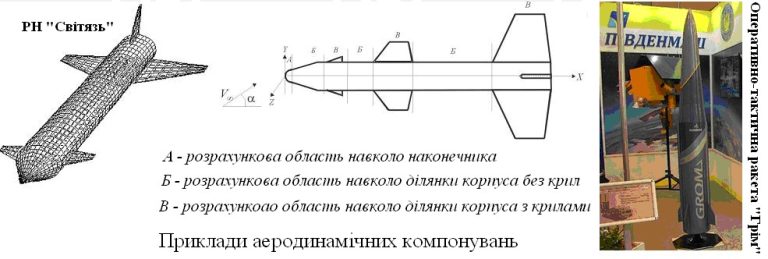
- hypersonic flow about aircraft with direct-flow air-jet engines. Marching algorithms have been developed and calculation methods have been created for operational complex calculations of spatial flows around the aircraft and thermogas-dynamic processes in the elements of the AJE (air intake device, combustion chamber, nozzle) integrated with the aircraft body. The use of calculation methods and software allows you to significantly reduce the terms of determining the design parameters of aircraft with AJE, which is especially important at the stage of preliminary determination of the parameters of their operation.

Jet flows of rocket engine fuel combustion products:
- interaction of subsonic and supersonic jet flows with a cocurrent supersonic and subsonic flow. Formulations of the corresponding problems as viscous interaction problems have been proposed and effective algorithms for their solution have been developed. Software and methods have been created to simulate afterburning rocket engine combustion products in atmospheric oxygen and water supply on jet parameters. The basic regularities of the influence of water supply, its evaporation, mixing and afterburning of combustion products in oxygen on the air flow structure and gas-dynamic and thermophysical parameters of the jet flow, which is of great importance in the ground firing of rocket engines, have been revealed;
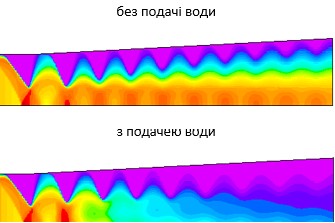
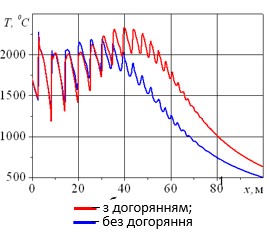
- flow in a block jet flow formed as a result of jet flow interaction of a multi-nozzle jet propulsion system. Based on the created software, the research can be conducted to study jet flows in the block jets for propulsion systems of different configurations.

Mathematical simulation of low-thrust jet engine systems:
- mathematical simulations have been formulated, algorithms, software and methods have been created to select the parameters of low-thrust liquid rocket engines (LREs), which are used as executive bodies of the control systems of the upper stages of launch vehicles and spacecraft. This AJE makes it possible to determine the design parameters of the LRE system taking into account the design features of the fuel pipelines, the degree of gas saturation of the fuel components, the dynamics of electrically controlled valves, unsteady thermogasodynamic processes in the combustion chambers and the parameters of the combustion products at the exits of the nozzle devices;
- the created AJE has been adapted for use at the State Enterprise “Yuzhnoye” Design Office for methodical support of the bench testing of the liquid-reactive system (LRS) for controlling the movement of the upper stage of the space rocket “Cyclone-4M”.
The features of the “Cyclone-4M” launch vehicle are the use of a multi-launch marching engine on the upper stage, which ensures the launch of several spacecraft into different orbits during one launch of the launch vehicle. For the first time in the global practice of space rocketry, the supply of fuel components to the combustion chambers of control LREs has been applied not from autonomous tanks with gas extrusion of fuel components, but from mains power supply of the main engine.
This construction of the LRE control power supply system makes it possible to increase the mass of the payload that is launched into orbit. At the same time, hydraulic shock processes occur in the power supply system due to the starts and stops of the cruising engine, which cause pressure and flow disturbances at the entrances to the control LRE.
| The scheme of liquid-jet system (LJS) powered from the main feed lines of the main engine | Control unit of low-thrust two-component jet engines for ground tests |
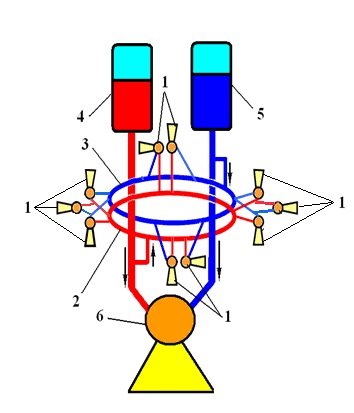 | 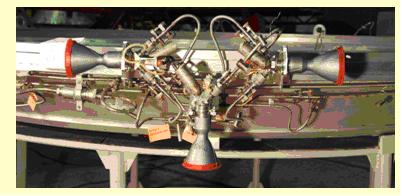 |
Calculation substantiation of the sufficiency of the types and volumes of the ground bench testing of the motion control system of the upper stage of the LV for the simulation of flight conditions has been performed.
With the use of this model, calculation and methods have been performed during the test of the control engine system during the fire ground test of the cruise engine of the upper stage of the “Cyclone-4M” LV, which made it possible to obtain additional information about the operation parameters of the control engines, which are technically difficult to determine during the fire tests.
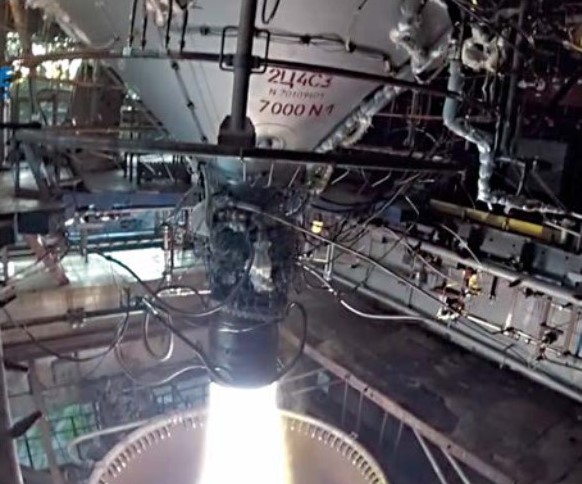
The aerodynamic effect of the rarefied oncoming flow and jets from the control LPRE on the spacecraft and the formation of its own external atmosphere around it in orbital conditions and in descent conditions:
- methods have been developed for statistical calculation of the total aerodynamic characteristics of the spacecraft, operating distributed loads and gas-dynamic parameters of the spacecraft’s own external atmosphere due to the action of the oncoming flow in the free-molecular and transition modes. Software has been created that makes it possible to predict the aerodynamic impact of a flow impinging on a spacecraft with a complex geometric shape for flight altitudes above 90 km. Numerical modeling of the flow around various spacecraft has been carried out for flight conditions in orbit and when entering the dense layers of the Earth’s atmosphere.
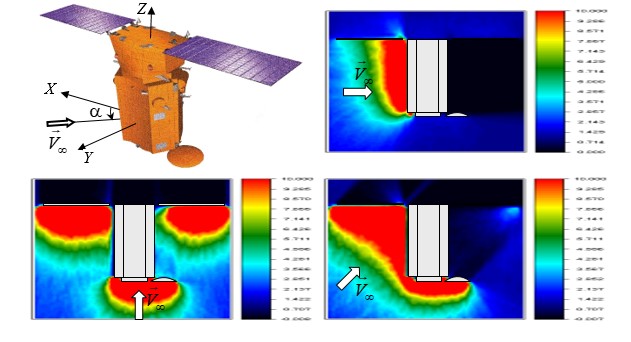
- the development of algorithms and scientific methods to solve the problems of three-dimensional flow around obstacles by a jet flow of rarefied gas is underway. The choice of the method of solving the equation is made taking into account the experience of working with statistical algorithms for calculating a homogeneous Maxwellian flow and the possibility of their modification for numerical modeling of rarefied jet flows.
THE DYNAMICS OF CONTROLLED DYNAMIC SYSTEMS
Improving the efficiency of using the resources of a controlled dynamic system (CDS) based on its active movement control using objective data on monitoring the current state of the CDS using on-board means, namely:
- algorithm synthesis for actively suppressing flexural vibrations of the CDS housing in the output section based on a mathematical simulation of flexural vibrations, which describes the reaction of the CDS housing to a set of external disturbances and is formed by reconstructing the current shape of the flexible axial line of the housing from measurements;
- algorithm synthesis for active control of the current hydrodynamic situation (HDS) in fuel tanks (FT) based on the results of measurements of the current values of the parameters of the real pressure field with subsequent identification of the HDS in the FT according to the content and movement of free gas inclusions at the entrance to the liquid jet engine;
- algorithm synthesis of the on-board active system of supporting the target efficiency of the rocket and space technology objects (improvement of its energy, target and cost characteristics), which combines the functions of the current state monitoring system, the objective control system and the active control system using the data of monitoring the current state of the CDS on-board means under the conditions of compensation of loads from the action of the dynamic environment in the event of uncalculated changes in the current state of the main systems and units – potential sources of accidents on board the CDS.
Publications:
Monographs
- Gorbuntsov V. V. Group-theoretic approach to solving combinatorial optimization problems. (in Russian) – Kyiv: Naukova Dumka, 1983. – 192 p.
- Tymoshenko V. I. The technology of numerical solution of problems in gas dynamics by using the electronic computer (in Russian) / V. I. Timoshenko, A. V. Limanskiy – Kiev : Naukova dumka, 1985. – 231 p.
- Tymoshenko V. I. Supersonic flows of viscous gas. (in Russian) – Kyiv: Naukova Dumka, 1987. – 183 p.
- Tymoshenko V. I. Computer technology of solving problems in gasdynamics. – New York: Begell house inc. Publishers, 1998. – 247 p.
- Tymoshenko V. I. Gas dynamics of high-temperature technological processes. (in Russian) – Dnepropetrovsk: ITM NASU and NKAU, 2003. – 460 p.
- Tymoshenko V. I. Theoretical foundations of technical gas dynamics. (in Russian) – Kyiv: Naukova Dumka, 2013. – 426p.
- Mazur V. L., Tymoshenko V. I. Theory and technology of rolling. Hydrodynamic effects of lubrication and surface microrelief. (in Russian) – Kyiv: “ADEF – Ukraine”, 2018. – 557p.
- Tymoshenko V. I. Computer modeling of aerothermogasdynamic processes in technical objects. – Kiev: Naukova Dumka, 2022. – 194 p.
Articles
- Tymoshenko V. I., Knyshenko Yu. V., Durachenko V. M., Anishchenko V. M. Problems of testing the control liquid reactive system powered from the main feed lines of the propulsion engine of the last stage of the launch vehicle (in Russian) – Space science and technology. – 2016. – Vol. 22, No. 1. – Pp. 20 – 35.
- Gorbuntsov V. V., Zavoloka A. N., Sviridenko N. F. Active flight control of the launch vehicle: a new approach and rational ways of its implementation (in Russian) – Technical mechanics. – 2016. – No. 2. – Pp. 32 – 43.
- Gorbuntsov V. V., Zavoloka A. N., Sviridenko N. F. Increasing the target efficiency of a medium-class space rocket: perspective directions of modernization (in Russian) – Technical mechanics. – 2016. – No. 4. – Pp. 50 – 61.
- Tymoshenko V. I. Computer simulation of aerothermogasdynamic processes in technical objects (rocket and space technology, energy, metallurgy) (in Ukrainian) – Bulletin of the National Academy of Sciences of Ukraine. – 2017. – No. 3. – Pp. 24 – 37.
- Tymoshenko V. I., Galinsky V. P. Numerical simulation of supersonic flow around launch vehicles equipped with fine control and stabilization elements (in Russian) – Space science and technology. – 2017. – Vol. 23, No. 5. – Pp. 33 – 43.
- Tymoshenko V. I. Quasi-homogeneous model of gas-dispersed flows with chemical reactions and phase transitions (in Russian) – NAS of Ukraine Reports. – 2018. – No. 2. – Pp. 34 – 42.
- Tymoshenko V. I., Knyshenko Yu. V. Influence of liquid gas saturation on the features of unsteady flows in complex pipelines (in Russian) – Engineering Physics Journal. – 2018. – Vol. 91, No. 6. – Pp. 1506 – 1516.
- Tymoshenko V. I., Galinsky V. P. Marching algorithms for calculating thermogasdynamic processes in ramjet engines integrated with an aircraft, taking into account spatial effects (in Russian) – Bulletin of engine building. – 2019. – No. 2. – Pp. 14 – 21.
- Pecherytsa L. L., Smila T. G. Grid structure optimization using the statistical method of test particles in sparse gas dynamics problems (in Russian) – Space science and technology. – 2020. – Vol. 26, No. 1. – Pp. 48 – 58.
- Tymoshenko V. I., Galinsky V. P. Mathematical simulation of the processes of aerogas thermodynamics of a supersonic aircraft with a ramjet engine (in Russian) – Space science and technology. – 2020. – Vol. 26, No. 2. – Pp. 3 – 18.
- Pecherytsa L .L., Smila T. G. Influence of proportions of orbital objects of simple form on their aerodynamic characteristics (in Russian) – Space science and technology. – 2021. – Vol. 28, No. 2 (128). – Pp. 48 – 58.
- Tymoshenko V. I., Galinsky V. P., Knyshenko Yu. V. Theoretical studies of aerogas dynamics of rocket and space technology objects (in Ukrainian) – Technical mechanics. – 2021. – No. 2. – Pp. 46 -59.
- Pecheritsya L. L., Smila T. G. Implementation of numerical methods of gas-dynamic expansions in problems of flowing around a barrier with a discharged strum stream (in Ukrainian) – Technical mechanics. – 2022. – No. 2. – Pp. 71 – 86.
- Tymoshenko V. I., Galinsky V. P. Calculation and methods for complex calculations of supersonic flow around aircraft with direct-flow jet engines (in Ukrainian) – Technical mechanics. – 2022. – No. 2. – Pp. 3 – 16.
| OFFICE ADDRESS: | Institute of Technical Mechanics , 15 Leshko-Popelya St., Dnipro, Ukraine, 49005 |
| PHONE NUMBER: | +38-056-372-06-41 |
| E-MAIL: | vitymoshenko@nas.gov.ua |

